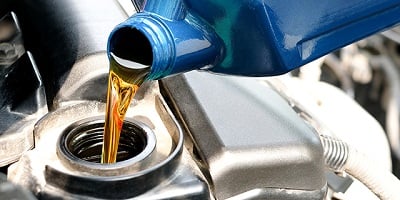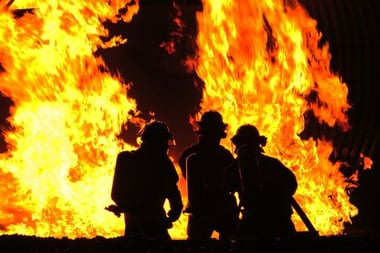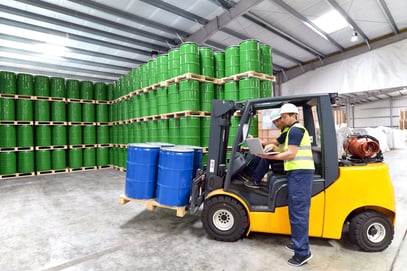Flammable liquids are volatile substances that require careful, comprehensive strategies to make sure that they’re safely used, stored and handled. We’ve created this blog to help you understand and evaluate the true risks of using flammable liquids in the workplace. Let’s get started by clarifying what we mean by ‘risk’ and ‘level of risk’.
Risk Vs Hazard
The words ‘risk’ and ‘hazard’ are often interchanged, but they refer to two different things.
A hazard, in the simplest of terms, is a danger. Safe Work Australia defines hazard as, “A situation or thing that has the potential to harm a person.”
 Flammable liquids have the physical and chemical properties to cause harm. The dangerous properties of these substances makes them a chemical hazard in workplaces.
Flammable liquids have the physical and chemical properties to cause harm. The dangerous properties of these substances makes them a chemical hazard in workplaces.
If your business is storing Dangerous Goods, a chemical hazard refers to the properties of a chemical that causes the substance to be dangerous ie flammable, corrosive, reactive, explosive etc.
HAZARD = DANGER
However, even when a chemical is recognised as being flammable or explosive, it doesn’t mean that it will catch fire or explode in your workplace. There are other factors that must be present — such as a chemical spill or leak, an ignition source or incompatible substances — for the chemical to ignite or react.
 When determining the true risks of using Class 3 Flammable Liquids, you must consider the exposure to danger that the chemical poses in your workplace.
When determining the true risks of using Class 3 Flammable Liquids, you must consider the exposure to danger that the chemical poses in your workplace.
Therefore, the term ‘risk’ refers to the exposure to danger: the potential for the hazard to create a dangerous incident, injury or illness. Safe Work Australia offers this definition for risk: “The possibility that harm (death, injury or illness) might occur when exposed to a hazard.”
RISK = EXPOSURE TO DANGER
Example Of Workplace Chemical Hazard
To further highlight the difference between hazards and risks, we’ll look at a common situation that may occur in an industrial, manufacturing or pharmaceutical premises.
This example focuses on the chemical hazard of flammable liquids such as the solvent toluene.
Example: Toluene is highly flammable solvent that can easily ignite when exposed to heat, sparks and flames. As this substance can float on water, it could run off into drains and sewers and cause explosions. The flammable vapours of toluene can be harmful to human health if inhaled. Ingesting or swallowing toluene can create narcotic effects as well as coma or death.
The properties of toluene which enable it to ignite, cause explosions and inflict human harm are all chemical hazards. But these hazards don’t represent the actual level of risk to your business.
.png?width=500&name=Untitled%20design%20(22).png) If you’re using flammable solvents, such as toluene, you must identify the chemical hazards of the substance and implement risk control measures to prevent harm to people, property and the environment.
If you’re using flammable solvents, such as toluene, you must identify the chemical hazards of the substance and implement risk control measures to prevent harm to people, property and the environment.
For example, if you prohibit the use of toluene outdoors — and ensure the chemical is always stored and handled over a spill bund — the risk of toluene escaping into a drain and exploding is low.
Level of Risk
To determine the level of risk that your flammable liquids pose to your organisation, it’s important to first identify the hazards that create the most risk.
Once the hazards have been identified, you can then allocate resources to control the potential risks.
To understand the full level of risk caused by Class 3 Flammable Liquids and other hazardous chemicals you need to look at four different areas:
- Hazard
- Potential Risk
- Use, Quantities & Location in Workplace
- Actual Risk
To make it easier, we’ve created this table to illustrate the process of determining the actual risk of using flammable liquids.
|
Hazard |
Potential Risk |
Use, Quantities & Location In Workplace |
Actual Risk |
|
Highly Flammable |
Will ignite when exposed to heat, sparks, and flames. Distant ignition and flash backs are possible. |
Used to regulate paint consistency. Vapours are released when containers are opened and chemical transferred to the paint tin. Difficult to assess the amount of ignition sources in high traffic handling area. |
High risk. Workers handle toluene on a daily basis.
|
|
Explosive |
Run off to sewers and drains can cause explosions. |
Toluene is only used indoors in small quantities. When not in use the chemical is stored in a compliant safety cabinet with spill containment. |
Low risk. It’s unlikely the chemical would escape into a drain. |
|
Harmful if swallowed |
Damage to throat, coma, death. |
The chemical is kept in the original containers which are well-marked and never dispensed into portable containers. Toluene has a distinct odour and workers are highly trained. |
Low risk. Unlikely someone would drink toluene. |
REMEMBER: The above table is a fictional representation of chemical usage to help you understand a process. Always conduct your own risk assessment based on the quantities, concentrations and actual use of chemicals at your own job site.
 To determine the level of risk when using flammable liquids, you must note the hazard, the potential risk and workplace factors including use and location.
To determine the level of risk when using flammable liquids, you must note the hazard, the potential risk and workplace factors including use and location.
What Factors Increase Chemical Risks?
When assessing the risks associated with flammable liquids — or any chemicals for that matter — you must consider the following critical factors:
- Chemical quantities - in very simple terms, 1,000 litres of petrol creates a much higher risk than 1 litre of petrol.
- Mixtures and handling - purchasing premixed liquids and fuels reduces handling times.
- Indoor vs outdoor use - outdoor environments can naturally dissipate flammable vapours, while indoor chemical storage can offer better spillage and environmental protection.
- Handling and processing times - the more often a fuel container is opened and used, the more vapours are released into the air.
- Incompatible substances - flammable liquids become more volatile and dangerous in the presence of oxidisers. This could come even come from the medical grade O2 at your first aid station.
- Heavy traffic zone - it’s harder to control potential ignition sources in work areas that have a lot of personnel coming and going.
The chemicals with the highest level of risk have the capability to create extremely dangerous incidents that could cause death or extensive property damage. So, by looking at the critical factors and controlling the chemical risks, you can work towards keeping your organisation safe and compliant.
 When assessing chemical risks, you must also consider a range of critical factors including chemical quantities, handling and processing times, and incompatible substances.
When assessing chemical risks, you must also consider a range of critical factors including chemical quantities, handling and processing times, and incompatible substances.
For example, if high risk chemicals are kept in large quantities, or used extensively, then the likelihood of dangerous events occurring is very high. But how can you reduce the chemical risks associated with Class 3 Flammable Liquids, such as fire, explosion and human harm?
Can You Minimise Chemical Risk Through Proper Storage?
One of the most efficient and reliable methods of reducing chemical risk is by implementing the correct storage practices in your workplace.
If you transfer even small containers of flammable liquids to a dedicated Class 3 safety cabinet or outdoor store, this control measure will have an immediate impact on the compliance and safety of your business.
 Choosing to store your flammable liquids in an indoor safety cabinet or outdoor store can provide your organisation with an effective and easy-to-implement risk management solution.
Choosing to store your flammable liquids in an indoor safety cabinet or outdoor store can provide your organisation with an effective and easy-to-implement risk management solution.
Indoor flammable cabinets and outdoor stores are specifically designed for each environment. They provide a range of risk control measures that will minimise the likelihood and impact of risks such as chemical spills and concentrated levels of hazardous vapours.
Features Of Indoor Flammable Liquids Cabinets
Flammable cabinets provide the following control measures:
- Offer liquid tight spill protection
- Minimise flammable vapours
- Help to keep chemical concentrations levels within workplace exposure standards
- Isolate chemicals from ignition sources
Features Of Outdoor Flammable Liquids Stores
Flammable outdoor stores are designed to achieve the following control measures:
- Maximise natural ventilation
- Isolate flammable liquids from work zones and production areas
- Provide environmental spill protection
- Secure chemicals from unauthorised workers, vandals and thieves
What Are The True Risks Of Using Flammable Liquids In Your Workplace?
Now that we’ve explained the process to determine the true risks of using flammable liquids in your workplace, you can take the next steps towards ensuring your business is 100% compliant. If you want to dig deeper into the topic of risk reduction, we invite you to download our free eBook. Essential Considerations When Storing Flammable Liquids Indoors is a helpful guide that will walk you through the risk management process. It contains lots of helpful tips and advice so you can select, install and maintain an indoor flammable liquids cabinet. Download our eBook for free and read it today.
Joining the team as a Dangerous Goods Storage Consultant, Melissa Hampton became Storemasta's Marketing Manager in late 2021. With extensive knowledge and experience in chemical compliance, Melissa is responsible for leading the Marketing team and helping shape their marketing strategy. In her spare time, you can find Melissa hiking, swimming and enjoying the great outdoors in beautiful north-west Tasmania.
